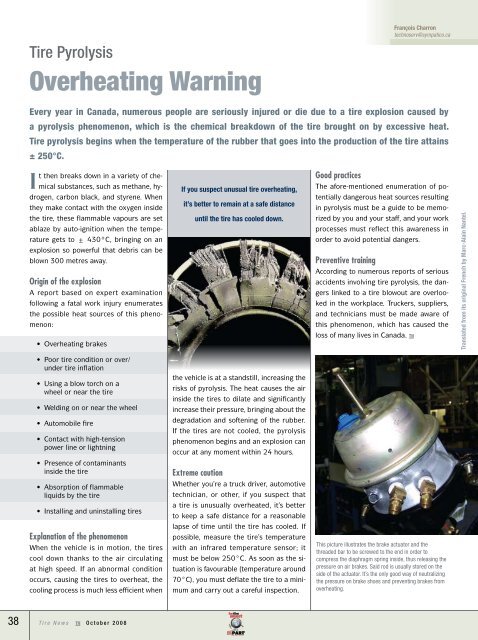Tire Dealers Association of Canada Convention - Autosphere
Tire Dealers Association of Canada Convention - Autosphere
Tire Dealers Association of Canada Convention - Autosphere
You also want an ePaper? Increase the reach of your titles
YUMPU automatically turns print PDFs into web optimized ePapers that Google loves.
tire Pyrolysis<br />
Overheating Warning<br />
Every year in <strong>Canada</strong>, numerous people are seriously injured or die due to a tire explosion caused by<br />
a pyrolysis phenomenon, which is the chemical breakdown <strong>of</strong> the tire brought on by excessive heat.<br />
<strong>Tire</strong> pyrolysis begins when the temperature <strong>of</strong> the rubber that goes into the production <strong>of</strong> the tire attains<br />
± 250°C.<br />
It then breaks down in a variety <strong>of</strong> chemical<br />
substances, such as methane, hydrogen,<br />
carbon black, and styrene. When<br />
they make contact with the oxygen inside<br />
the tire, these flammable vapours are set<br />
ablaze by auto-ignition when the temperature<br />
gets to ± 430ºC, bringing on an<br />
explosion so powerful that debris can be<br />
blown 300 metres away.<br />
Origin <strong>of</strong> the explosion<br />
A report based on expert examination<br />
following a fatal work injury enumerates<br />
the possible heat sources <strong>of</strong> this phenomenon:<br />
• Overheating brakes<br />
• Poor tire condition or over/<br />
under tire inflation<br />
• Using a blow torch on a<br />
wheel or near the tire<br />
• Welding on or near the wheel<br />
• Automobile fire<br />
• Contact with high-tension<br />
power line or lightning<br />
• Presence <strong>of</strong> contaminants<br />
inside the tire<br />
• Absorption <strong>of</strong> flammable<br />
liquids by the tire<br />
• Installing and uninstalling tires<br />
Explanation <strong>of</strong> the phenomenon<br />
When the vehicle is in motion, the tires<br />
cool down thanks to the air circulating<br />
at high speed. If an abnormal condition<br />
occurs, causing the tires to overheat, the<br />
cooling process is much less efficient when<br />
38 <strong>Tire</strong> News tn October 2008<br />
If you suspect unusual tire overheating,<br />
it’s better to remain at a safe distance<br />
until the tire has cooled down.<br />
the vehicle is at a standstill, increasing the<br />
risks <strong>of</strong> pyrolysis. The heat causes the air<br />
inside the tires to dilate and significantly<br />
increase their pressure, bringing about the<br />
degradation and s<strong>of</strong>tening <strong>of</strong> the rubber.<br />
If the tires are not cooled, the pyrolysis<br />
phenomenon begins and an explosion can<br />
occur at any moment within 24 hours.<br />
Extreme caution<br />
Whether you’re a truck driver, automotive<br />
technician, or other, if you suspect that<br />
a tire is unusually overheated, it’s better<br />
to keep a safe distance for a reasonable<br />
lapse <strong>of</strong> time until the tire has cooled. If<br />
possible, measure the tire’s temperature<br />
with an infrared temperature sensor; it<br />
must be below 250°C. As soon as the situation<br />
is favourable (temperature around<br />
70°C), you must deflate the tire to a minimum<br />
and carry out a careful inspection.<br />
Good practices<br />
The afore-mentioned enumeration <strong>of</strong> potentially<br />
dangerous heat sources resulting<br />
in pyrolysis must be a guide to be memorized<br />
by you and your staff, and your work<br />
processes must reflect this awareness in<br />
order to avoid potential dangers.<br />
Preventive training<br />
François Charron<br />
technoserv@sympatico.ca<br />
According to numerous reports <strong>of</strong> serious<br />
accidents involving tire pyrolysis, the dangers<br />
linked to a tire blowout are overlooked<br />
in the workplace. Truckers, suppliers,<br />
and technicians must be made aware <strong>of</strong><br />
this phenomenon, which has caused the<br />
loss <strong>of</strong> many lives in <strong>Canada</strong>. tn<br />
This picture illustrates the brake actuator and the<br />
threaded bar to be screwed to the end in order to<br />
compress the diaphragm spring inside, thus releasing the<br />
pressure on air brakes. Said rod is usually stored on the<br />
side <strong>of</strong> the actuator. It’s the only good way <strong>of</strong> neutralizing<br />
the pressure on brake shoes and preventing brakes from<br />
overheating.<br />
Translated from its original French by Marc-Alain Nantel.






